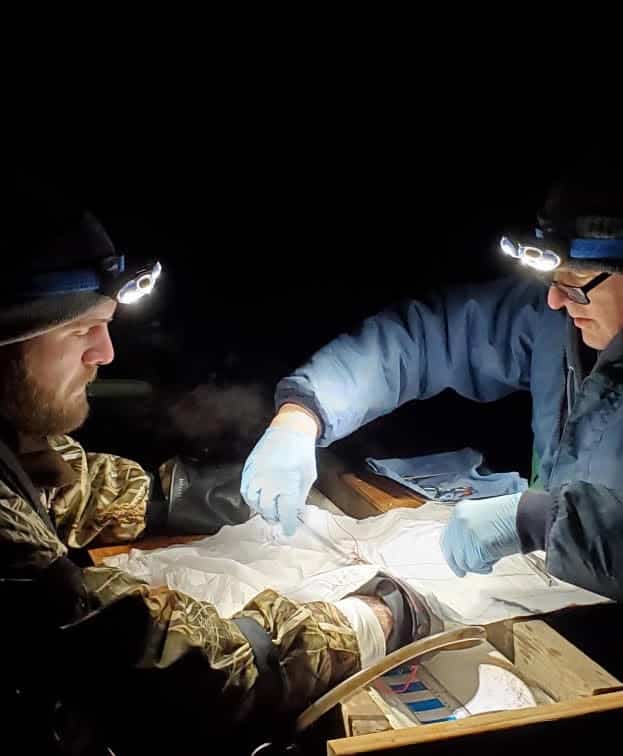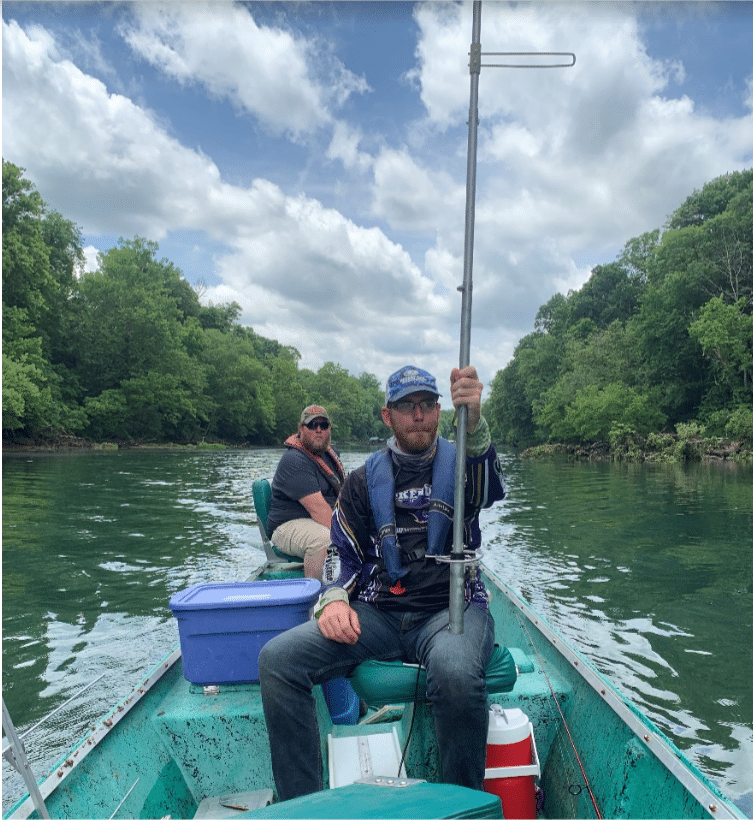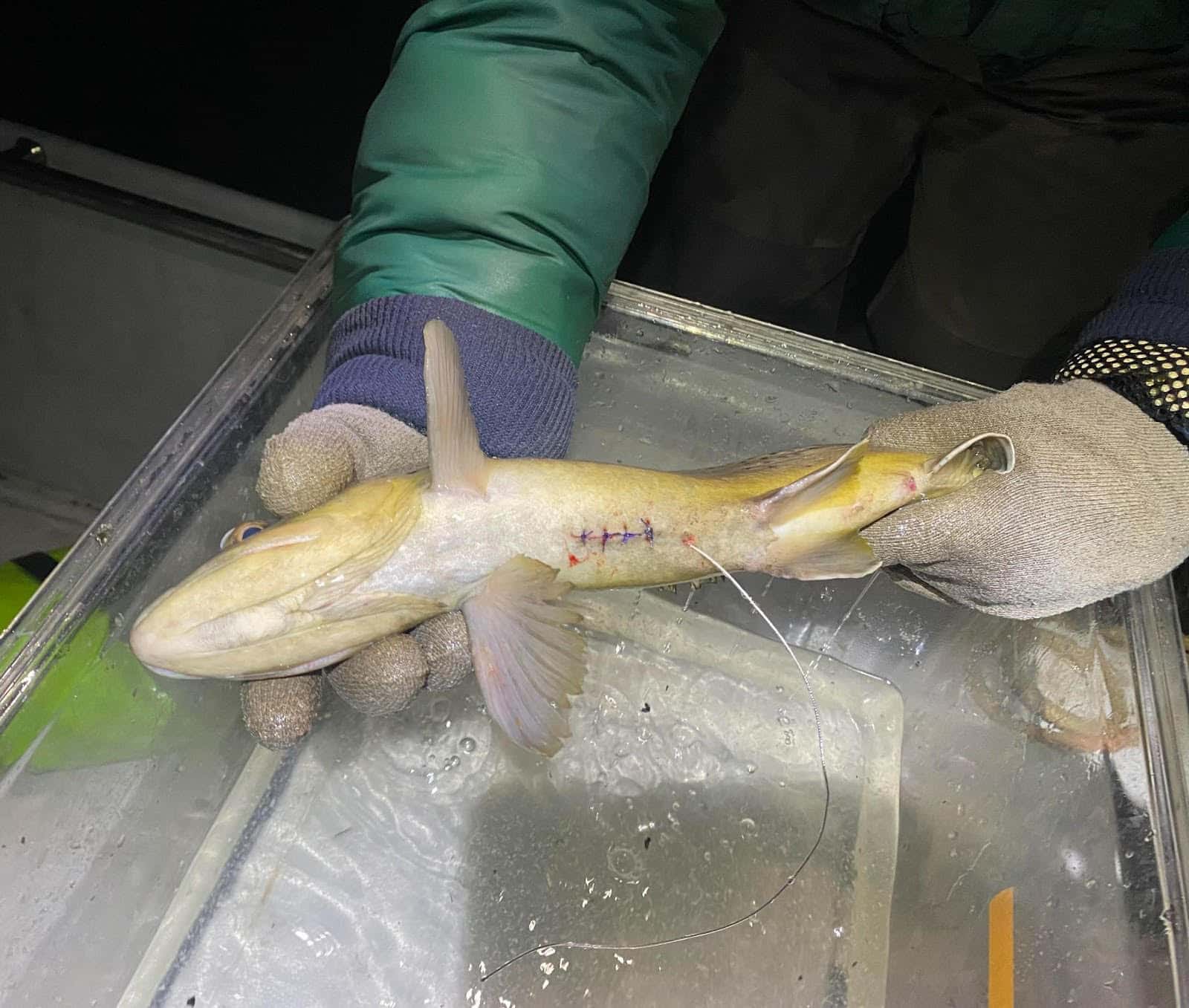AGFC, UAPB tune in to trout movements on Little Red River
ON 04-17-2024

HEBER SPRINGS — With thousands of brown trout swimming in Arkansas tailwaters, it’s hard to single out one as special, so the Arkansas Game and Fish Commission picked 150. That’s the number of brown trout swimming in the Little Red River below Greers Ferry Dam being followed throughout the year by the AGFC and researchers from the University of Arkansas at Pine Bluff.
Radio transmitters implanted in the trout send a signal that “pings” off a series of receivers up and down the river to record movements on a daily basis. This new location data can then be used to investigate how outside influences affect their routines.
According to Arkansas Game and Fish Commission Trout Program Coordinator Christy Graham, the research is the latest in the series of studies scheduled with public input from the 2017 Greers Ferry Tailwater Management Plan.
“Researching the brown trout population to better manage this fishery was a major priority in the plan, and we’ve already had some great projects,” Graham said. “All our previous studies on the tailwater focused on seasonal movements. Now technology lets us track on a daily basis and build on the knowledge we’ve already gained. We have the opportunity to really dive into how flow rates and water temperature affect movement, trout movement rates and locations between day and night, and get a little more of a glimpse at why the trout are using different resources throughout the year. These are all vital components to ensure we’re providing enough protection to the fishery and may reveal areas where we could improve it further.”
Researchers began the project in December by collecting brown trout from pools of the river along various locations from Greers Ferry Dam to Searcy.

“Although the traditional trout waters end at Monaghan Womack Access where Highway 305 crosses the river, the researchers tagged fish from Highway 305 to Searcy to determine if there is a resident population in that portion of the river and if those fish are moving into the managed portion of the river during certain times of the year,” Graham said.
Previous research played a big part in the effort as well, according to Graham.
“Spawning research conducted by UAPB from 2020-2021 pointed out the shallow riffles and shoals that contain high numbers of spawning fish, and we avoided all of those areas to prevent disturbing the spawn as much as possible,” Graham said.
Researchers surgically implanted radio transmitters into the undersides of the fish, taking care to place the units where they would cause no harm and not interfere with the fish’s ability to swim or feed. Rather than using chemicals or drugs to anesthetize the fish during surgery, the team used specialized gloves that used low rates of electric current to immobilize the fish. This allowed them to complete the surgery quickly without long recovery times or side effects. Fish were able to swim away within minutes of the procedure, and very little, if any, mortality has been noticed thus far.
“They have received signals from 147 of the 150 transmitters so far, so we’re confident that very little complications were experienced as a result of the implantation surgeries,” Graham said. “The radio antenna protruding from the underside of the fish may seem a bit odd if an angler catches one, but that long antenna is needed to help the signal penetrate the water far enough to be picked up by receivers placed along the river.”
Graham says she has heard reports from many anglers and seen social media posts about catching some of the fish. Anglers are asked to consider releasing the fish to help continue the study, but if they do harvest them to please give the location and time where they were caught. Graham says the news that tagged fish are being caught is actually encouraging.

“It means the transmitters aren’t interfering with the trout’s behavior,” Graham said. “They’re still being trout and doing trout things, so they should represent movements of other brown trout in the system.”
Graham says they’ve already seen some fascinating results from the study, including one fish that swam 806 miles up and down the river within the first 6 weeks of being tagged.
“If you look at that one’s movements, it just kept going up and down the river from just above Cow Shoals all the way to the Ramsey Access,” Graham said.
UAPB researchers aren’t just sitting and waiting for the receivers to collect data, either. They’ve also boated up and down the river periodically with a portable radio receiver to capture locations on fish that may be homebodies.
“Each signal is unique, so once all of these data are collected, we’ll be able to compare each fish’s movement and look at all the local factors that may have played a role in their behavior,” Graham said. “This is really the first time I know of any research like this being done on brown trout in Arkansas, or anywhere else for that matter.”

Graham has coordinated with UAPB to hold a public meeting regarding trout management, habitat and research on the Greers Ferry Tailwater from 5:30 p.m.-7:30 p.m. May 7 in Room 3 of the Heber Springs Community Center at 201 Bobbie Jean Lane. Anyone interested in the radio telemetry project or other research being conducted on the river is encouraged to attend.
“We also give regular updates on our research through our Fisheries newsletters and AGFC Fisheries Division Facebook Page,” Graham said. “Those are great resources to keep up with all of the work going on throughout the state for trout as well as warmwater fisheries in The Natural State.”
####
CUTLINES
BROWN TROUT IN HANDS
Researchers from UAPB are involved in an extensive telemetry study to learn more about daily movements of brown trout on the Little Red River below Greers Ferry Dam. Photo courtesy of UAPB.
RESEARCHERS IMPLANTING TRANSMITTER
Special gloves were used to immobilize trout while completing the surgery, preventing the need for chemicals or drugs to accomplish the project. Photo courtesy of UAPB.
RESEARCHERS IN BOAT
Radio signal receivers are placed along the Little Red River to detect fish movements, and researchers survey the areas between the stationary receivers to fill in any gaps. Photo courtesy of UAPB.
TROUT AFTER SURGERY
Although unsightly, the transmitter surgeries have not affected the small number of tagged trout’s ability to swim or feed. Photo courtesy of UAPB.
Recent News

AGFC Commissioner Meeting Notice
Jul. 15, 2025

Arkansas Wildlife Weekly Fishing Report
Jul. 10, 2025
Subscribe to Our Weekly Newsletter E-mails
Don’t miss another issue. Sign up now to receive the AGFC Wildlife Weekly Newsletter in your mailbox every Wednesday afternoon (Waterfowl Reports are published weekly during waterfowl season and periodically outside the season). Fishing Reports arrive on Thursdays. Fill in the following fields and hit submit. Thanks, and welcome!
